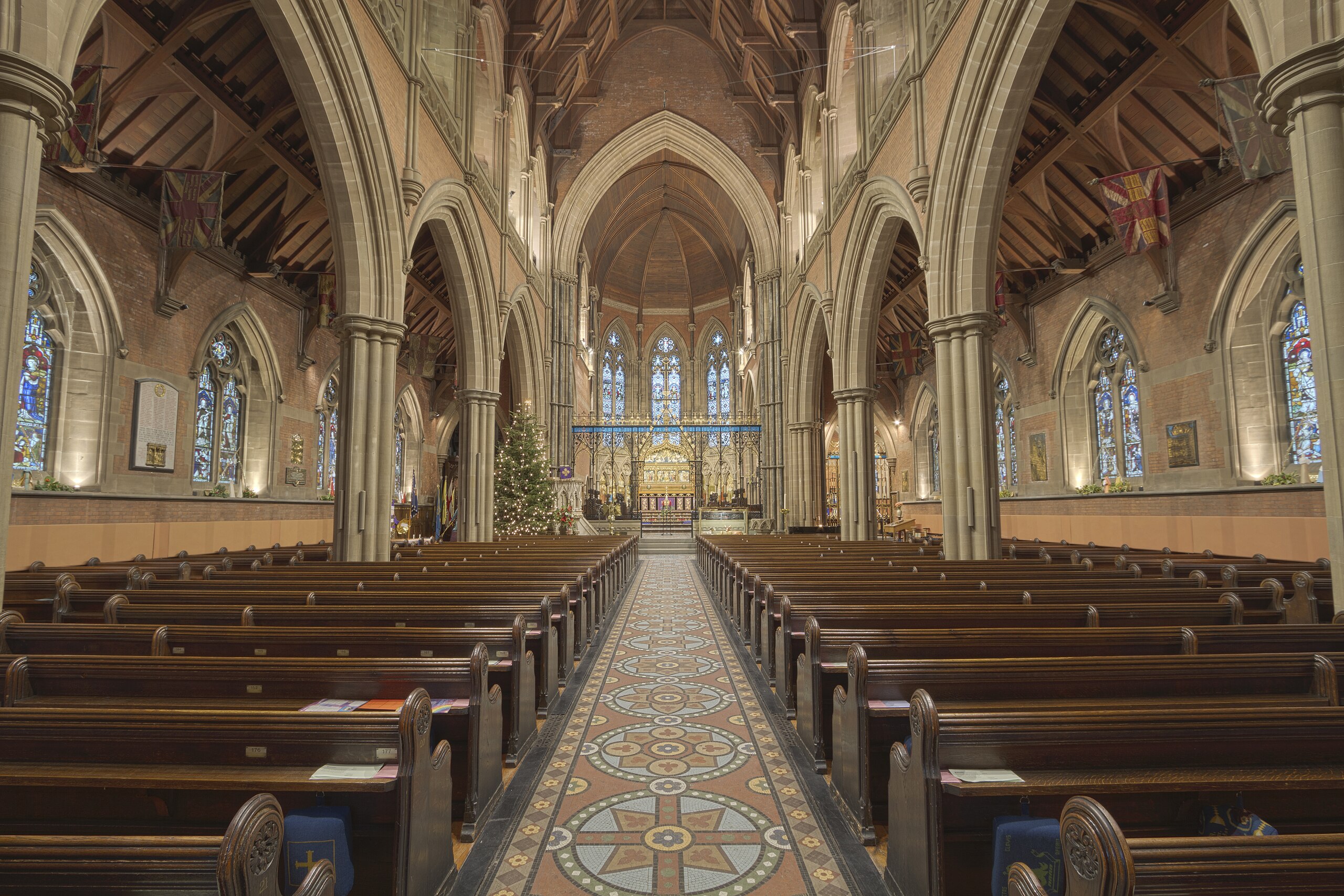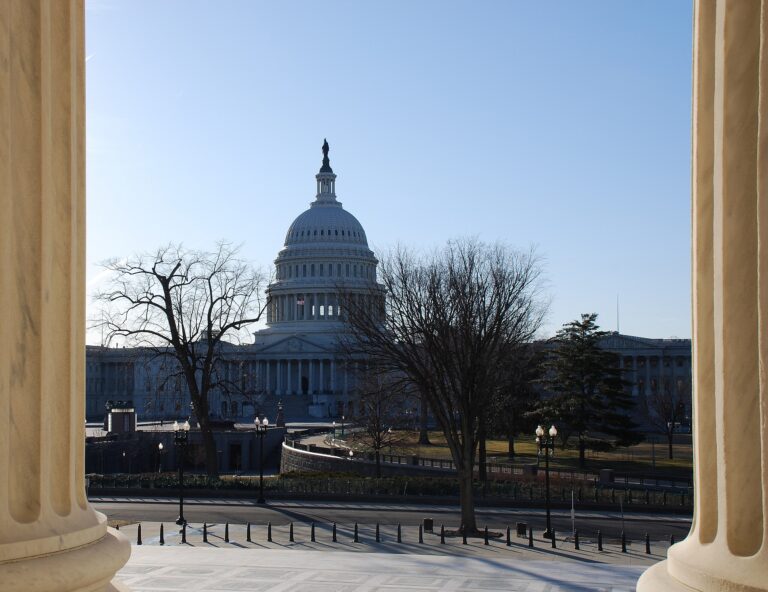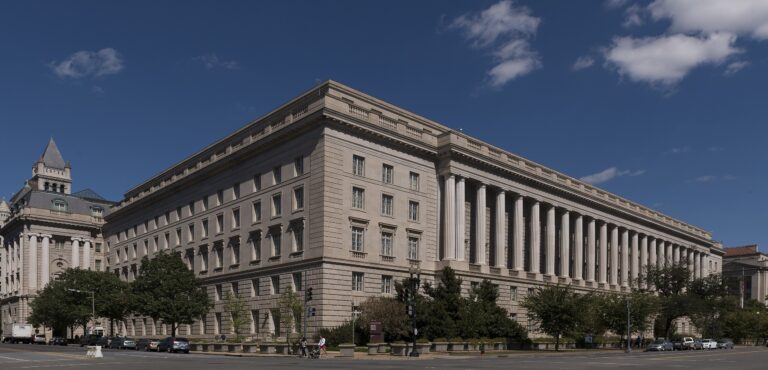
Seeing like a Church, Seeing like a State: The Church-State Relation in Religious Asylum Adjudications
Jaeeun Kim
Parish Church of Saint Mary the Virgin in Bury, England. Photo by Michael Beckwith (CC BY 3.0).
Religion is one of the five categories of protection—along with race, nationality, political opinion, and membership in a particular social group—designated by the international and domestic refugee regimes. Migrants who claim a “well-founded fear of persecution” on account of religion if returned can apply for refugee status in the U.S. and elsewhere. While the contemporary refugee regime tends to focus on persecution on account of “immutable” identities, asylum claims on account of religion are different. Since the freedom of conscience entails the freedom to change one’s religion, asylum applicants can cite a religious conversion that took place after leaving their countries of origin as a source of a “well-founded fear of persecution.” This so-called “bootstrapping” asylum claim, however, is subject to greater scrutiny.
Numerous studies have shown how religious organizations operate as an engine of immigrant assimilation into the host state or as their sanctuary from the state’s exclusionary power. The development of religious asylum adjudications in the last two decades or so, especially in the U.S., sheds light on the hitherto under-explored ways in which state and church interact in the context of international migration. On the one hand, the development of religious asylum adjudications highlights the critical role that faith-based advocacy has played in making persecution on account of religion a salient issue in asylum adjudications in the U.S. On the other hand, it shows how religious organizations are incorporated, not without tensions, into the state’s effort to verify the religious identities of asylum applicants.
International Religious Freedom Act (IRFA) and Asylum Adjudications
The 1998 International Religious Freedom Act (IRFA) made a significant contribution toward religious persecution becoming a salient issue in asylum adjudications in the U.S. IRFA called upon the U.S. government to make “the fundamental right to freedom of religion” central to foreign policy-making through diplomatic sanctions and aid disbursement. IRFA created the Office of International Religious Freedom (OIRF) within the State Department, as well as the quasi-governmental U.S. Commission on International Religious Freedom (USCIRF) that was designed to play a watchdog role. These organizations produce annual country reports on religious freedom. They also publish a list of “countries of particular concern” (CPC), based on which the president can make decisions as to which diplomatic sanctions to impose.
The language of IRFA, backed by an interfaith coalition, encompassed all religious traditions. However, the influence of powerful evangelical mobilization on its adoption and implementation is unmistakable, as Castelli, McAlister, and Bruner have shown. The law was grounded in the broader theo-political discourse that represented America as the covenantal nation and raised the alarm on the “war on Christians” both at home and abroad. “The Statement of Conscience Concerning Worldwide Religious Persecution,” published in 1996 by the National Association of Evangelicals (NAE), is illustrative. It declared “religious liberty” to be a “God-given human right” as well as “the bedrock principle that animates our republic and defines us as a people.” The plea that the U.S. government must “secure the blessings of religious liberty to all those suffering religious persecution” followed. If the NAE shrewdly combined biblical mandates with human rights language, other organizations active in this advocacy were less shy about their exclusive focus on persecuted Christians. Their position was informed by their decades of commitment to missionary and evangelical outreach in communist and Muslim-majority countries, as well as the popularization of the discourse of global Christian persecution from the late 1980s onward.
Especially pertinent to the topic of this essay is the reform of relevant asylum laws and practices mandated by Congress. IRFA directed the Attorney General to offer asylum officers, immigration judges, and other immigration officers more robust training on the freedom of religion. The influence of these recommendations is shown in the Asylum Officer Basic Training Manuals/Modules on the topic. Asylum adjudicators are encouraged to adopt a broad interpretation of religious persecution and show greater deference to varying manifestations of religious identities in their “credibility assessment.” To be sure, how effectively this training has been translated into day-to-day asylum adjudications is debatable. It still wouldn’t be a stretch to assume that these government initiatives have buttressed asylum claims-making on religious grounds. This is more likely the case for asylum-seekers from the countries designated as CPC in the annual reports of OIRF and USCIRF. I’d like to note that IRFA specifically noted congressional concern for Christians in China, which never missed the CPC designation from 1999 up to 2023.
Admittedly, the asylum officer training module emphasizes that whether the asylum applicant’s country of origin is included in the CPC list should not automatically determine the outcome of individual cases. Nonetheless, inclusion in the “Countries of Particular Concern” list can make the burden of establishing a well-founded fear of persecution less onerous for applicants from these countries. It is easier for them to establish that their persecution is on account of religion, not the execution of a religiously neutral law or an act of violence of private actors motivated by different types of animosity.
For example, USCIRF has thrown its weight behind the claim that prosecuting individuals running an underground church in China is persecution on account of religion, not the enforcement of an ordinary law prohibiting unregistered religious organizations. By contrast, evangelicals targeted by gang members in Guatemala, Honduras, and El Salvador face a more daunting challenge to establish that their victimization by these non-state actors is on account of religion.
Seeing like a Church, Seeing like a Persecutor
Individuals who apply for asylum on religious grounds must pass through multiple hoops to establish their eligibility for refugee status. For the purpose of this essay, I’d like to focus on what legal scholars call the “credible membership test.” That is, asylum adjudicators should be able to establish whether the applicant credibly belongs to a religious group that suffers persecution. This is especially the case for asylum claims based on a post-departure conversion, since their sincerity is subject to greater scrutiny.
The “credible membership test” that relies heavily on the applicant’s knowledge of the faith at issue has been consistently criticized in relevant training modules, guidelines, case law, and academic and advocacy publications throughout the 2000s. The knowledge test systematically favors individuals who are highly educated, better resourced, and familiar with legal and bureaucratic settings, to the disadvantage of those who live their religion in different ways. Accordingly, the UNHCR guidelines encourage asylum adjudicators to employ “a narrative form of questioning,” allowing the claimant to explain “how he or she adopted the religion, the place and manner of worship, or the rituals engaged in, the significance of the religion to the person, or the values he or she believes the religion espouses.” This line of questioning, of course, is not an unproblematic endeavor. Religions are practiced differently around the world. Suppression of a religious group affects its practice. Linguistic and cultural differences further undermine the adjudicator’s capacity to read interactional cues and emotional expressions accurately.
Some legal scholars have pointed out a deeper constitutional problem underlying the sincerity tests. By identifying certain beliefs, practices, and affiliations as indicia of credible religious membership, the asylum process makes the state “see like a church” and inevitably partake in establishing religious orthodoxy, potentially violating the anti-establishment clause of the Constitution. Individuals with heterodox beliefs, practices, and affiliations can be determined as insincere by asylum adjudicators. To avoid this thorny constitutional issue, several legal scholars have encouraged asylum adjudicators to prioritize the perception of persecuting agents over their own, namely, whether applicants are likely to be seen as true believers by persecuting agents. In other words, instead of “seeing like a church,” asylum adjudicators should strive to “see like a persecutor.” It is in this spirit that, in Najafi v. INS, involving a Muslim-to-Christian convert from Iran, the 7th Circuit Court recommends that the court should not be overly obsessed with “the heart of the convert” and “shift the focus […] from Indianapolis [where the petitioner allegedly converted] to Iran.”
Suggestively, the “eye of the persecutor test” is most frequently mobilized for cases involving countries where the punishment of apostasy is well documented. In other cases, it is used to contain the excess of the sincerity test rather than completely replace it. In a nutshell, religious asylum adjudications make it inevitable for the state to draw the boundary between authentic religious identities and deceptive masquerades.
Can the Church “See like a State”?
What has been under explored in legal scholarship on the so-called “religious imposter problem” is how the petitioner’s engagement with religious organizations in the country of asylum often becomes the object of interrogation. The certificates of membership and baptism issued by these religious organizations, or the recommendation letters or personal testimonies in court offered by pastors, priests, rabbis, and imams, are often featured centrally in the credible membership test.
For example, the aforementioned Najafi v. INS notes that, in addition to producing “a letter from the church treasurer which stated that Najafi visits worship service [in the Indianapolis Church of Christ] periodically,” Najafi even submitted “bank records from December 1990 to September 1991 detailing small contributions [to the church] totaling $227.” In fact, the failure to provide certificates of membership and baptism, if not the evidence of donations, can undermine the asylum claim. This was the case in Saif v. Holder,1Saif v. Holder, 452 Fed. Appx. 631 involving an alleged Christian convert from Yemen. The 6th Circuit Court sustained the adverse credibility findings of the immigration judge and the Board of Immigration Appeals (BIA), highlighting that “Saif failed to provide any reliable corroborating evidence that he had attended church regularly—either through a letter or a witness that could confirm his regular attendance.” Although “Saif’s ex-wife did testify that Saif had regularly attended church,” the credibility of her testimony was undermined by her financial dependence on Saif.
The discrepancies, both big and small, between the testimony of the asylum applicant and that of the religious authority can become the basis of adverse credibility findings. In Cui v. Rosen,2Cui v. Rosen, 842 Fed. Appx. 42 for example, the different baptism dates that Cui and his pastor respectively gave to the court worked to Cui’s disadvantage. In Jiang v. Sessions,3Jiang v. Sessions, 734 Fed. Appx. 78 it was the discrepancy in the testimonies of Jiang and her pastor about the distribution of church fliers that made the court rule that Jiang was not credible: “Jiang testified that her church ‘does not ever pass out flyers’ […] However, Jiang’s pastor testified that church members generally handed out flyers in the spring […]” Shaban v. INS4 Shaban v. INS, 91 Fed. Appx. 608 illustrates how the religious authority brought to the court to back up the asylum applicant’s conversion can end up serving as the state’s surrogate gatekeeper. The religious instructor’s testimony that “[Shaban] never told him of his previous conversion and the instructor believed [Shaban to be] ignorant of Christianity’s basic tenets when they met” undermined Shaban’s claim that he had converted to Christianity back in the home country.
These court cases reveal that religious organizations in the country of asylum tend to be seen as a relatively disinterested and objective party, as compared to the petitioner’s family, friends, or neighbors who may have vested interest in the success of the petitioner’s asylum claim (like Saif’s ex-wife mentioned above). To borrow the classic “principal-agent dilemma” from political science, one can say that the church is seen as a more reliable “agent” than other private parties for the immigration state to delegate its screening function.
This isn’t necessarily the case in Europe. Several recent studies show that asylum adjudicators often suspect bad faith on the part of religious organizations. In Germany, for example, immigration judges reportedly accuse some evangelical congregations of conducting “assembly-line baptisms” (Taufen am Flieβband) for Muslim asylum-seekers without a proper vetting process. Asylum adjudicators, as well as media reports, imply that asylum-seekers who fill the long-empty benches of the otherwise dying churches in Europe are too attractive for pastors to turn away. By contrast, according to Nijhawan’s study, Ahmadi Jama’at (the religious community for Ahmadi Muslims) in Germany is criticized for denying certificates of membership to asylum-seekers from Pakistan because they are not sufficiently fundamentalist. A more mundane motive behind “illegitimate” gatekeeping is also highlighted. Der Spiegel, for example, reported in 2014 on the alleged attempt within the Jama’at to extract disproportionately high membership fees from asylum-seekers asking for certificates of membership for court hearings.
In all these examples, asylum adjudicators are skeptical if the religious organization at issue is driven by “dubious” motives, whether it is the zeal for proselytization or boundary policing, or simply, the pursuit of various instrumental gains, financial or not. Both too much and too little religion seems to make these religious organizations a deficient surrogate gatekeeper for the state. After all, the church does not “see like a state,” to borrow James Scott’s celebrated metaphor.
Religious organizations, for their part, take offense at such suspicion. Christianity Today contends that the explosive growth of Christian congregations in Germany through the massive conversion of Muslim asylum-seekers is not the evidence of asylum-seeker’s opportunism or pastors’ turning blind eyes to it. Rather, it is evidence of “a laughing God at work”: He planned a revival in places like Saxony, the birthplace of the Reformation, where “Christians have become an endangered species.” From the perspective of religious organizations, the state’s effort to independently verify the religious identity of their members constitutes a problematic infringement of their own jurisdiction. For example, comparing the Finnish Immigration Service’s assessment of asylum-seeker conversion to the Spanish Inquisition, a columnist of a Christian newspaper in Helsinki, Kirkko ja kaupunki, sarcastically commented: “The only difference was that in present-day Finland the sentencing was being done not by priests, but rather government bureaucrats and judges.” In a similar vein, the German branch of the evangelical organization Open Doors argued in its 100-page special report that “only providers of pastoral care possess the authority and expertise to make assessments of the credibility of conversion.” In Germany, this jurisdictional dispute went all the way to the Federal Constitutional Court.
This kind of jurisdictional dispute between church and state has not yet surfaced as prominently on the U.S. side. One might wonder if a long history of religious freedom litigations in the U.S. high courts encourages asylum adjudicators to exercise greater restraint in directly contesting the authority of religious organizations. Moreover, USCIRF seems to provide religious organizations with an institutionalized channel through which to voice their concerns about, and focus their reform efforts on, relevant law enforcement. However, the suspicion of bad faith on the part of certain religious organizations and actors seems to inform law enforcement activities, if not case law. A 2013 New York Times article, for example, reported on the charge brought against church worker Liying Lin that she coached asylum-seekers on how to pretend to be Christians in cahoots with unscrupulous migration industry actors. Her lawyer, interviewed by the NYT, argued that Li was motivated not by expected material benefits, but by the desire of evangelization.
Beyond a Legal Analysis
These various disputes over religious asylum adjudications highlight how the boundaries between church and state, between religion and non-religion, and between “proper” and “improper” religion are contested through the discourse of “religious freedom,” as Hurd has astutely observed. These disputes further engender a set of questions that cannot be answered solely through a legal analysis. How has the discourse of global religious (more specifically, Christian) persecution been translated into the day-to-day operation to establish “a well-founded fear of persecution on account of religion”? How do religious organizations respond to the state’s request to help verify the sincerity of asylum-seekers’ religious identities? If religious organizations are less interested in screening the faithful than in producing them, how does this distinctive interest shape their relation to the state and to asylum-seekers? And how do asylum-seekers navigate the discrete demands of the state and the church over the course of the asylum process? Answering these questions would require us to ethnographically examine the complex interaction among various stakeholders in asylum offices, immigration courts, and religious congregations. ♦
Acknowledgments
I appreciate Clary Baudraz’s research assistance. The writing of this essay was supported by the Laboratory Program for Korean Studies through the Ministry of Education of the Republic of Korea and the Korean Studies Promotion Service of the Academy of Korean Studies [AKS-2018-LAB-2250001].

Jaeeun Kim is Korea Foundation Associate Professor of Sociology and Professor of Law (by Courtesy) at the University of Michigan. She is the author of Contested Embrace: Transborder Membership Politics in Twentieth-Century Korea (Stanford University Press 2016) and several articles, including “Between Sacred Gift and Profane Exchange: Identity Craft and Relational Work in Asylum Claims-Making on Religious Grounds.” She was a member of the Institute for Advanced Study in Princeton (2016–2017) and a fellow at Wissenschaftskolleg zu Berlin (2020–2021), where she will hold a non-resident permanent fellow position from 2024 to 2029.
Recommended Citation
Kim, Jaeeun. “Seeing like a Church, Seeing like a State: The Church-State Relation in Religious Asylum Adjudications.” Canopy Forum, May 23, 2024. https://canopyforum.org/2024/05/23/seeing-like-a-church-seeing-like-a-state-the-church-state-relation-in-religious-asylum-adjudications/.
Recent Posts










